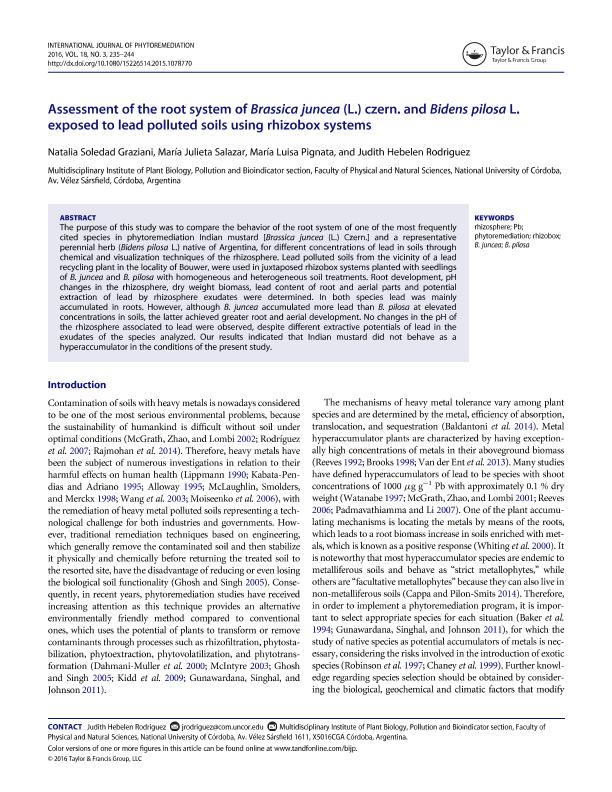Artículo
Assessment of the root system of Brassica juncea (L.) czern. and Bidens pilosa L. exposed to lead polluted soils using rhizobox systems
Graziani, Natalia Soledad ; Salazar, María Julieta
; Salazar, María Julieta ; Pignata, Maria Luisa; Rodriguez, Judith Hebelen
; Pignata, Maria Luisa; Rodriguez, Judith Hebelen
 ; Salazar, María Julieta
; Salazar, María Julieta ; Pignata, Maria Luisa; Rodriguez, Judith Hebelen
; Pignata, Maria Luisa; Rodriguez, Judith Hebelen
Fecha de publicación:
03/2016
Editorial:
Taylor & Francis
Revista:
International Journal of Phytoremediation
ISSN:
1522-6514
e-ISSN:
1549-7879
Idioma:
Inglés
Tipo de recurso:
Artículo publicado
Clasificación temática:
Resumen
The purpose of this study was to compare the behavior of the root system of one of the most frequently cited species in phytoremediation Indian mustard [Brassica juncea (L.) Czern.] and a representative perennial herb (Bidens pilosa L.) native of Argentina, for different concentrations of lead in soils through chemical and visualization techniques of the rhizosphere. Lead polluted soils from the vicinity of a lead recycling plant in the locality of Bouwer, were used in juxtaposed rhizobox systems planted with seedlings of B. juncea and B. pilosa with homogeneous and heterogeneous soil treatments. Root development, pH changes in the rhizosphere, dry weight biomass, lead content of root and aerial parts and potential extraction of lead by rhizosphere exudates were determined. In both species lead was mainly accumulated in roots. However, although B. juncea accumulated more lead than B. pilosa at elevated concentrations in soils, the latter achieved greater root and aerial development. No changes in the pH of the rhizosphere associated to lead were observed, despite different extractive potentials of lead in the exudates of the species analyzed. Our results indicated that Indian mustard did not behave as a hyperaccumulator in the conditions of the present study.
Palabras clave:
B. JUNCEA
,
B. PILOSA
,
PB
,
PHYTOREMEDIATION
,
RHIZOBOX
,
RHIZOSPHERE
Archivos asociados
Licencia
Identificadores
Colecciones
Articulos(IMBIV)
Articulos de INST.MULTIDISCIPL.DE BIOLOGIA VEGETAL (P)
Articulos de INST.MULTIDISCIPL.DE BIOLOGIA VEGETAL (P)
Citación
Graziani, Natalia Soledad; Salazar, María Julieta; Pignata, Maria Luisa; Rodriguez, Judith Hebelen; Assessment of the root system of Brassica juncea (L.) czern. and Bidens pilosa L. exposed to lead polluted soils using rhizobox systems; Taylor & Francis; International Journal of Phytoremediation; 18; 3; 3-2016; 235-244
Compartir
Altmétricas



